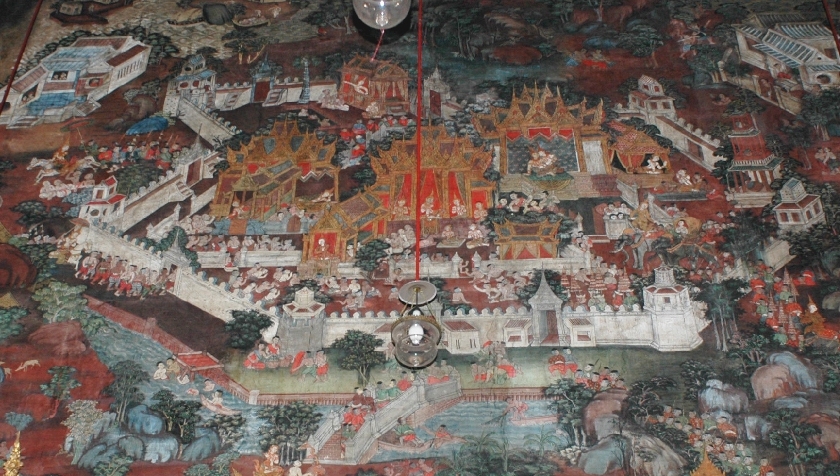The Analysis of Themes on the Murals inside the Ordination Hall of Wat Phra Chetuphon
Keywords:
the mural painting, King Rama III, Wat Phra Chetuphon, Mahosot Jataka, the forty-one great disciplesAbstract
The ordination hall of Wat Phra Chetuphon is one of the most important masterpieces from the reign of King Rama III. Inside the hall, the forty-one great disciples were portrayed on the walls between the windows while Mahosot Jataka was painted on the walls above the windows. Both themes and their painting techniques differ from Thai traditional paintings of the earlier period. Thus, the selection of these two themes is related to various concepts and beliefs, and reflects society of that time. The occurrence of these two themes emphasizes King Rama I’s habit of accumulating various types of knowledge and his own intention of naming this temple “Phra Chetuphon”. For example, Mahosot Jataka is the story in which the Buddha preached to his disciples in Chetavan Monastery or Chetuphon. Thus, it was likely that this Jataka was chosen owing to the name of this temple. Moreover, the story of Mahosot is related to disease treatment: this theme was in accordance with the status of Wat Phra Chetuphon as the center of medicinal knowledge. The story of forty-one great disciples was related to the Buddha’s disciples, each was an expert in one field. Thus, painting them on the walls between the windows was relevant to the intention of letting all monks observe and follow these role models.
References
กุสุมา รักษมณี, 2530. ลักษณะเฉพาะของวรรณคดีพระบาทสมเด็จพระนั่งเกล้าเจ้าอยู่หัว, เอกสารประกอบการบรรยายเนื่องในวาระ 200 ปี พระบาทสมเด็จพระนั่งเกล้าเจ้าอยู่หัว 31 มีนาคม 2530 ณ มหาวิทยาลัยศิลปากร วังท่าพระ. (เอกสารอัดสำเนา).
กุสุมา รักษมณี, 2530. ลักษณะเฉพาะของวรรณคดีสมัยพระบาทสมเด็จพระนั่งเกล้าเจ้าอยู่หัว. กรุงเทพฯ: มหาวิทยาลัยศิลปากร.
คณะสงฆ์วัดพระเชตุพน, 2544. ประชุมจารึกวัดพระเชตุพน. พิมพ์ครั้งที่ 6. กรุงเทพฯ: อมรินทร์พริ้นติ้งแอนด์พับลิชชิ่ง.
ดำรงราชานุภาพ, สมเด็จพระเจ้าบรมวงศ์เธอ กรมพระยา, 2543. “อธิบายเรื่องการสอบพระปริยัติธรรม.” ใน ชุมนุมพระนิพนธ์สมเด็จฯ กรมพระยาดำรงราชานุภาพ. กรุงเทพฯ: สำนักพิมพ์บรรณกิจ (1991) จำกัด.
ทิพากรวงศมหาโกษาธิบดี, เจ้าพระยา, 2538. พระราชพงศาวดารกรุงรัตนโกสินทร์ รัชกาลที่ 3. พิมพ์ครั้งที่ 6. กรุงเทพฯ: กองวรรณกรรมและประวัติศาสตร์ กรมศิลปากร.
นริศรานุวัดติวงศ์, สมเด็จเจ้าฟ้ากรมพระยา และดำรงราชานุภาพ, สมเด็จกรมพระยา, 2504-2506. สาส์นสมเด็จ เล่ม 18. กรุงเทพฯ: แพร่พิทยา.
นายมี มหาดเล็ก, 2517. กลอนเพลงยาวสรรเสริญพระเกียรติพระบาทสมเด็จพระนั่งเกล้าเจ้าอยู่หัว. พิมพ์ครั้งที่ 4. กรุงเทพฯ: กรมศิลปากร.
บัณฑิต ลิ่วชัยชาญ, 2550. “ภัยฝรั่ง” สมัยพระนั่งเกล้าฯ. กรุงเทพฯ: มติชน.
ปรมานุชิตชิโนรส, สมเด็จพระมหาสมณเจ้า กรมพระ, 2547. โคลงดั้นเรื่องปฏิสังขรณ์วัดพระเชตุพน. กรุงเทพฯ: สหธรรมิก.
วรรณณิภา ณ สงขลา, 2534. วรรณกรรม. กรุงเทพฯ: ฝ่ายอนุรักษ์จิตรกรรมฝาผนังและประติมากรรมติดที่ กองโบราณคดี กรมศิลปากร.
วอลเตอร์ เอฟ. เวลลา, 2514. แผ่นดินพระนั่งเกล้าฯ. (แปลโดย นิจ ทองโสภิต). กรุงเทพฯ: สมาคมสังคมศาสตร์แห่งประเทศไทย.
ศูนย์รวมหนังสือเพื่อการศึกษา วัดพระเชตุพน, 2519. สิ่งน่ารู้ในวัดโพธิ์. พิมพ์ครั้งที่ 2. กรุงเทพฯ: โรงพิมพ์แพร่พิทยา.
สน สีมาตรัง, 2549. “พิจารณาจิตรกรรมฝาผนัง วัดสุทัศนเทพวรารามและวัดพระเชตุพนวิมลมังคลาราม.” ใน พระราชเวที (สุรพล ชิตญาโณ) (บรรณาธิการ), วิหารพระนอนวัดโพธิ์ (หน้า 114-168). กรุงเทพฯ: วัดพระเชตุพนวิมลมังคลาราม.
สันติ เล็กสุขุม, 2544. รายงานผลการวิจัย จิตรกรรมไทยสมัยพระบาทสมเด็จพระนั่งเกล้าเจ้าอยู่หัว: ความคิดเปลี่ยน การแสดงออกที่เปลี่ยนตาม (ฉบับร่าง). กรุงเทพฯ: สำนักงานคณะกรรมการวิจัยแห่งชาติ.
สันติ เล็กสุขุม, 2548. ข้อมูลกับมุมมอง: ศิลปะรัตนโกสินทร์. กรุงเทพฯ: เมืองโบราณ.
สำนักงานคณะกรรมการวัฒนธรรมแห่งชาติ, 2533. 200 ปี สมเด็จพระมหาสมณเจ้ากรมพระยาปรมานุชิตชิโนรส. กรุงเทพฯ: สำนักงานคณะกรรมการวัฒนธรรมแห่งชาติ กระทรวงศึกษาธิการ.

Downloads
Published
Issue
Section
License
บทความนี้เป็นผลงานของข้าพเจ้าแต่เพียงผู้เดียว และ/หรือเป็นผลงานของข้าพเจ้าและผู้ร่วมงาน ตามชื่อที่ระบุในบทความจริง และเป็นผลงานที่มิได้ถูกนำเสนอหรือตีพิมพ์ที่ใดมาก่อน

